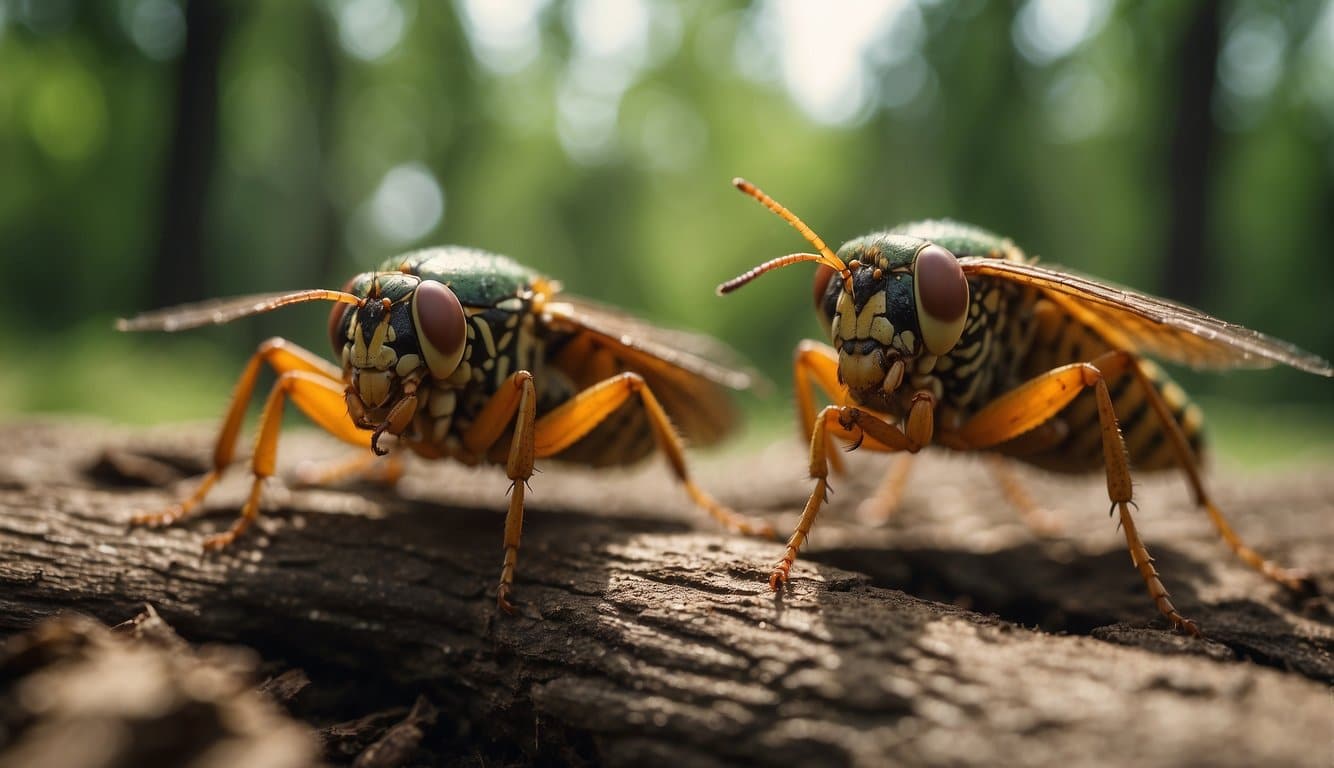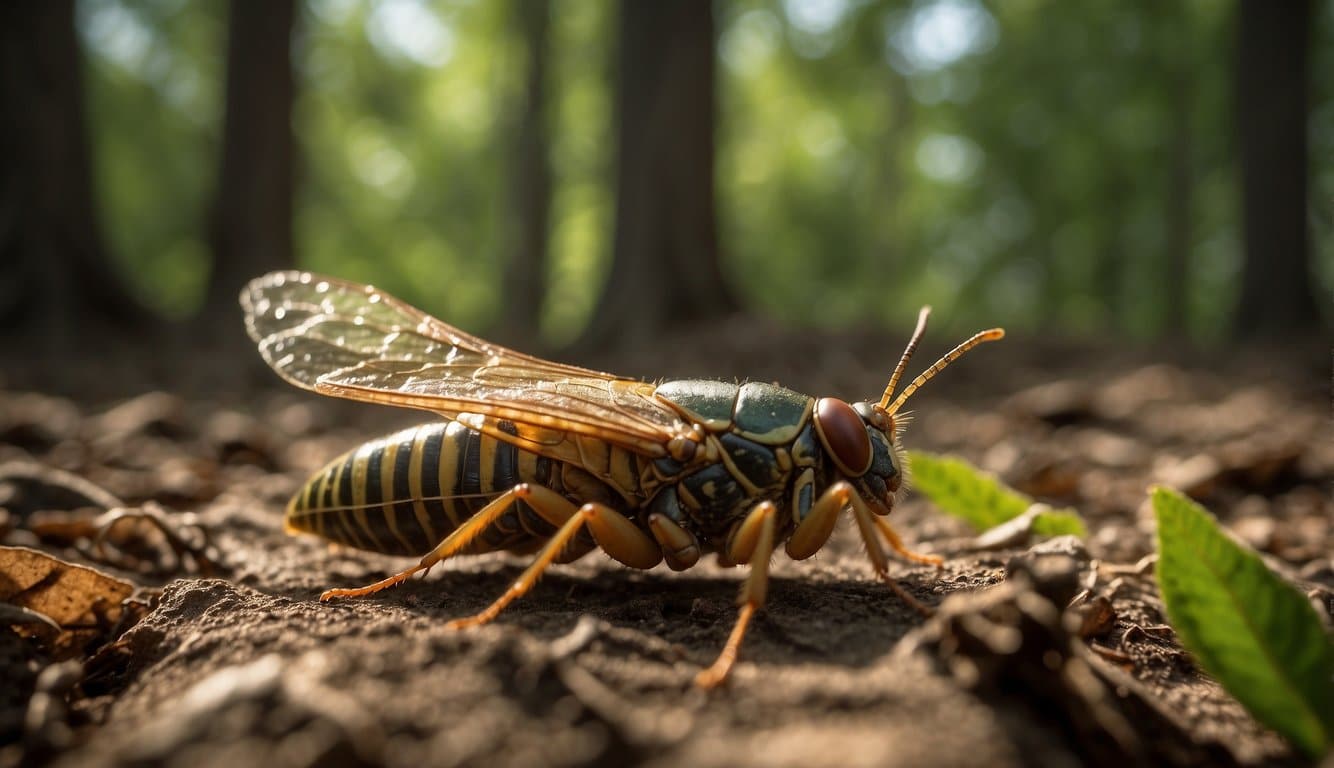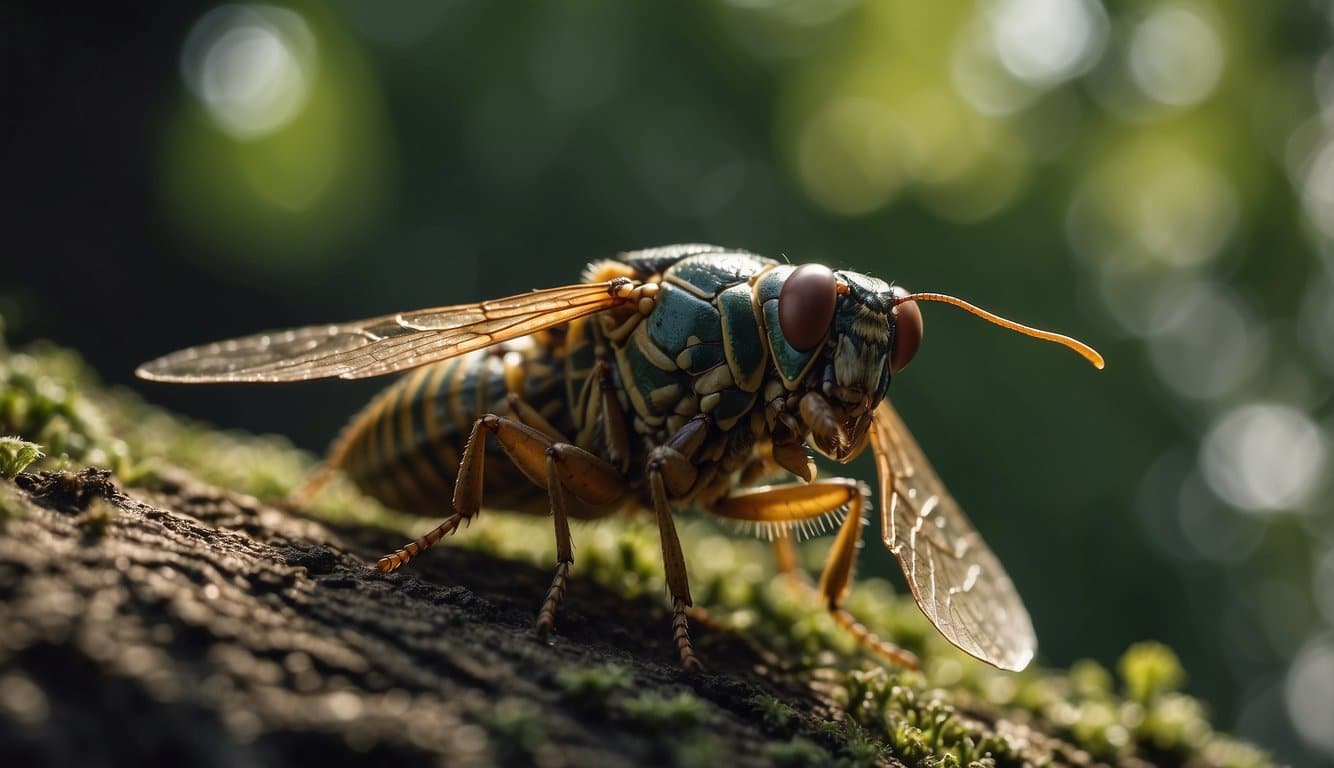Life Cycle Stages of Cicadas
Cicadas are the rock stars of the insect world, with life cycles that are as fascinating as they are unique! Here’s a backstage pass to the three main acts of their life cycle:
- Egg: Your adventure begins in the treetops with the tiny cicada eggs.
- Females lay eggs in tree branches.
- Eggs hatch into nymphs.
- Nymph: As a cicada nymph, you’ll dive underground.
- Nymphs burrow and feed on roots.
- They undergo several molts.
- Adult: Now you’ve hit the big time!
- Nymphs emerge after years to molt into adults.
- Adults have a short lifespan to mate and lay eggs.
Act 1: The Egg Phase
Imagine yourself as a tiny egg nestled in a slender tree twig, waiting to hatch. This part of your journey is brief but critical.
Act 2: The Nymph Phase
You’ll spend most of your life underground as a nymph, feasting on sap and growing through a series of molts.
- Fall to the ground
- Grow through 5 molting stages
Act 3: The Adult Phase
Your grand finale: you emerge after years to sing, mate, and start the next generation. Your time in the limelight is short but unforgettable.
- Sing loud and proud
- Mate to continue the cycle
Periodical vs. Annual Cicadas
In the fascinating world of cicadas, understanding the differences between periodical and annual species is key to appreciating these incredible insects you might encounter in your backyard or while exploring the great outdoors.
Emergence Timelines
- Periodical Cicadas: These remarkable insects operate on a unique schedule. They emerge en masse every 13 or 17 years, depending on their brood. Imagine thousands, even millions, surfacing in synchrony for a brief, noisy appearance before disappearing again for over a decade. Learn more about their timelines from Wildlife Informer.
- Annual Cicadas: On the flip side, you have the annual cicadas, which grace us with their presence each year. Unlike their periodical counterparts, annual cicadas don’t have a synchronized mass emergence—some are always maturing and surfacing each summer. For further details, see WKRN News 2.
Life Span Differences
- Periodical Cicadas: It’s hard to believe, but these cicadas live most of their lives underground. This subterranean phase can last either 13 or 17 years. They feed on plant roots in a slow adolescent progression until their grand entrance as adults. For in-depth information about their lifecycle, check out Birds and Blooms.
- Annual Cicadas: They might be called annual, but these cicadas typically spend about 2 years underground as nymphs, which is significantly shorter than their periodical friends. Each year a different brood emerges, which is why you see them annually. For more insights, refer to USA Today.
Mating Rituals and Behaviors
When you stumble upon the loud, symphonic sound of cicadas, you’re actually eavesdropping on their mating call. Here’s what’s happening in that buzzing canopy:
- Male Serenade: Your backyard becomes a concert venue where male cicadas belt out acoustic signals to woo females. They’re equipped with special organs called tymbals, which flex in and out to create those iconic sounds.
- Female Response: If a female digs the vibe, she’ll flick her wings in reply. It’s her way of saying, “Let’s get to know each other!” This wing-flick carries a soft, subtle click that’s hard for you to hear, but not for Mr. Cicada.
Once they’ve matched, it’s time for the face-to-face—or antennae-to-antennae—encounter.
- The Approach: The male will sidle up closer to the female, continuing his serenade to maintain her interest.
- The Affirmation: If the female remains receptive, her steady wing flicking encourages the male’s advances.
- The Union: Successful courtship leads to mating, where they’ll couple end-to-end. This can last several hours, during which they’re quite vulnerable to predators.
Post-Mating: After the deed is done, the female wastes no time. She’ll seek out tender twigs where she can deposit her eggs—ensuring the next generation kicks off their subterranean journey.
Development and Growth
In your journey to discover the fascinating world of cicadas, you’ll find their life cycle to be a meticulous process of transformations. From the initial egg, deep underground development as nymphs, to the final act of metamorphosis into winged adults, each stage is a wonder of nature tailored for survival.
Egg Stage
After mating, a female cicada accomplishes the extraordinary task of laying hundreds of eggs. Here’s what happens:
- Location: She carefully selects tree branches and makes slits to deposit her eggs.
- Timing: The eggs will hatch in 6 to 10 weeks depending on environmental factors.
Nymph Stage
Once the eggs hatch, the cicada’s life underground begins:
- Drop and Dig: Tiny nymphs drop to the ground and burrow beneath the surface.
- Feeding: They feed on root sap, growing slowly yet steadily over several years.
During this time, cicadas undergo several stages of molting, shedding their exoskeletons and incrementally increasing in size. They live a solitary life, avoiding the hazards of the above-ground world while preparing for their eventual emergence.
Adult Transformation
Finally, cicadas are ready to face the sunlight:
- Emersion: Nymphs emerge from the ground after years of development.
- Final Molting: Their final molt reveals the adult cicada, wings and all.
Ecological Impact and Predation
When you’re out there marveling at the cacophony of cicadas, consider the dramatic role these insects play in their ecosystem. Here’s the buzz on their ecological impact and how predation weaves into their life cycle:
- Resource Pulse: During cicada emergence years, there’s an all-you-can-eat buffet for predators. Research indicates that the predation pressure on other species, like caterpillars, drops as birds and other animals gorge on the abundant cicadas.
- Trophic Cascade: Your treasured oak saplings experience a breather from herbivory. With birds busy snapping up cicadas, caterpillar populations increase, leading to higher herbivory rates on other plants. This shift in diet for birds during a cicada emergence can significantly affect the food web dynamics in a forest.
- Nutrient Recycling: Think of cicadas as nature’s fertilizer machines. When their life ends, their bodies decompose, releasing nutrients into the soil. This enriches the forest floor, giving a kick-start to plant growth.
Now, let’s highlight some key players in the cicada predation game:
- Birds: Your usual avian friends switch their diet temporarily to include cicadas, leading to a decrease in their usual predation activities.
- Mammals: From small rodents to adventurous domestic pets, many mammals enjoy a cicada snack.
- Insects and Arachnids: Yes, even the smaller critters get in on the action, preying on cicadas in various stages of their life cycle.
Frequently Asked Questions
Curious about the buzzing phenomena of cicadas? Here’s the lowdown on what you need to know about their extraordinary life cycle.
How long do cicadas actually live above ground?
Cicadas spend the majority of their life underground, but once they emerge, their adult stage above ground lasts for about four to six weeks. During this time, they mate, lay eggs, and then die shortly after.
What are the distinct stages of a cicada’s life cycle?
The cicada goes through three primary stages: egg, nymph, and adult.
The nymph stage is spent entirely underground, which can last for several years—2 to 17 years, depending on the species.
What roles do cicadas play in the ecosystem?
Cicadas are crucial for their ecosystems as they are a food source for various predators and their underground activity aerates the soil.
Their mass emergence every few years also provides a nutrient-rich boost to the environment when they die.
How can you identify the different broods of cicadas?
You can identify the different broods of cicadas by the timing of their emergence.
Periodical cicadas emerge either every 13 or 17 years, which is predictable depending on the brood.
What transformations do cicadas go through during their development?
Cicadas transform from a nymph to an adult in a process known as molting.
They emerge from the ground, attach to a surface, and shed their exoskeleton. They then wait for their new wings and exoskeleton to harden.
What are the reasons behind cicadas’ lengthy life cycle?
The lengthy life cycle is thought to be a survival strategy called predator satiation.
By emerging in massive numbers at intervals of 13 or 17 years, cicadas overwhelm predators who can’t possibly consume them all, ensuring enough survive to reproduce.


